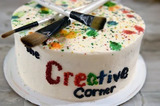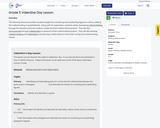
Identifying and describing parts of a circle and relationship between the parts - Mathematics Instructional Plan
- Subject:
- Mathematics
- Material Type:
- Lesson Plan
- Provider:
- VDOE
- Author:
- VDOE
- Date Added:
- 10/07/2024

Identifying and describing parts of a circle and relationship between the parts - Mathematics Instructional Plan

Learn why artists have been featuring food as a subject in their work for centuries. You’ve been told to eat your vegetables, but have you ever tried to paint them? Special Guest Lisa McLaughlin, the baker behind Jesse’s Girl Cookies, invites us into her kitchen to experiment with modern art techniques on cakes, and then we’ll make our own painting of a scrumptious treat inspired by 20th-Century painter Wayne Thiebaud.

This is a google slides mini lesson on diameter and radius of a circle. The first slide consists of a definition of a diameter and radius. Students will discuss and realize the difference between the two. Then they will make a text box for the answer. They will type the answer in the text box, then complete the slides.

This learning resource provides students insight into combining and subdividing figures as well as utilizing the understanding of quadrilaterals. Along with the exploration, students will be developing critical thinking through the decisions that are made to create the final mathematical product. They will also communicate through collaboration to produce a final mathematical product. They will also develop creative thinking and citizenship by producing a written piece to show their caring and understanding nature.

Video Description: In addition to planets and their moons, there are many small bodies orbiting the Sun. How did these bodies form? Learn more about comets and asteroids and the role these play in our Solar System, as well as NASA's Rosetta and NEOWISE missions. Video Length: 3:09.NASA eClipsTM is a suite of online student-centered, standards-based resources that support instruction by increasing STEM literacy in formal and nonformal settings. These free digital and downloadable resources inform and engage students through NASA-inspired, real-world connections.NASA eClips Real World segments (grades 6-8) connect classroom mathematics to 21st Century careers and innovations. They are designed for students to develop an appreciation for mathematics through real-world problem solving.